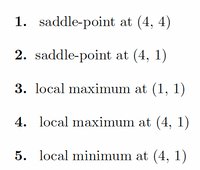
Calculus: Early Transcendentals
8th Edition
ISBN: 9781285741550
Author: James Stewart
Publisher: Cengage Learning
expand_more
expand_more
format_list_bulleted
Question

Transcribed Image Text:1. Saddle-point at (4, 4)
2. Saddle-point at (4, 1)
3. Local maximum at (1, 1)
4. Local maximum at (4, 1)
5. Local minimum at (4, 1)
![**Problem Statement:**
Locate and classify the local extremum of the function
\[ f(x, y) = x^2 + y^2 - 8x - 2y + 6. \]
**Analysis:**
To find the local extrema of the given function, we need to follow these steps:
1. **Find the Critical Points:**
- Compute the partial derivatives of \( f(x, y) \) with respect to \( x \) and \( y \).
- Set these partial derivatives to zero to find the critical points.
2. **Classify the Critical Points:**
- Use the second derivative test for functions of two variables to classify each critical point.
- Compute the second partial derivatives.
- Calculate the determinant of the Hessian matrix.
- Use the determinant to determine whether each critical point corresponds to a local minimum, local maximum, or saddle point.
These are the steps involved in locating and classifying the local extrema of the given function of two variables.](https://content.bartleby.com/qna-images/question/2acbb8d8-ea7d-469f-beb1-443cebbd2d53/2bc8b5b5-ce76-41f4-8cd5-5b237824e487/nqxfm34_thumbnail.png)
Transcribed Image Text:**Problem Statement:**
Locate and classify the local extremum of the function
\[ f(x, y) = x^2 + y^2 - 8x - 2y + 6. \]
**Analysis:**
To find the local extrema of the given function, we need to follow these steps:
1. **Find the Critical Points:**
- Compute the partial derivatives of \( f(x, y) \) with respect to \( x \) and \( y \).
- Set these partial derivatives to zero to find the critical points.
2. **Classify the Critical Points:**
- Use the second derivative test for functions of two variables to classify each critical point.
- Compute the second partial derivatives.
- Calculate the determinant of the Hessian matrix.
- Use the determinant to determine whether each critical point corresponds to a local minimum, local maximum, or saddle point.
These are the steps involved in locating and classifying the local extrema of the given function of two variables.
Expert Solution
This question has been solved!
Explore an expertly crafted, step-by-step solution for a thorough understanding of key concepts.
This is a popular solution
Trending nowThis is a popular solution!
Step by stepSolved in 3 steps with 3 images

Knowledge Booster
Similar questions
Recommended textbooks for you
 Calculus: Early TranscendentalsCalculusISBN:9781285741550Author:James StewartPublisher:Cengage Learning
Calculus: Early TranscendentalsCalculusISBN:9781285741550Author:James StewartPublisher:Cengage Learning Thomas' Calculus (14th Edition)CalculusISBN:9780134438986Author:Joel R. Hass, Christopher E. Heil, Maurice D. WeirPublisher:PEARSON
Thomas' Calculus (14th Edition)CalculusISBN:9780134438986Author:Joel R. Hass, Christopher E. Heil, Maurice D. WeirPublisher:PEARSON Calculus: Early Transcendentals (3rd Edition)CalculusISBN:9780134763644Author:William L. Briggs, Lyle Cochran, Bernard Gillett, Eric SchulzPublisher:PEARSON
Calculus: Early Transcendentals (3rd Edition)CalculusISBN:9780134763644Author:William L. Briggs, Lyle Cochran, Bernard Gillett, Eric SchulzPublisher:PEARSON Calculus: Early TranscendentalsCalculusISBN:9781319050740Author:Jon Rogawski, Colin Adams, Robert FranzosaPublisher:W. H. Freeman
Calculus: Early TranscendentalsCalculusISBN:9781319050740Author:Jon Rogawski, Colin Adams, Robert FranzosaPublisher:W. H. Freeman
 Calculus: Early Transcendental FunctionsCalculusISBN:9781337552516Author:Ron Larson, Bruce H. EdwardsPublisher:Cengage Learning
Calculus: Early Transcendental FunctionsCalculusISBN:9781337552516Author:Ron Larson, Bruce H. EdwardsPublisher:Cengage Learning

Calculus: Early Transcendentals
Calculus
ISBN:9781285741550
Author:James Stewart
Publisher:Cengage Learning

Thomas' Calculus (14th Edition)
Calculus
ISBN:9780134438986
Author:Joel R. Hass, Christopher E. Heil, Maurice D. Weir
Publisher:PEARSON

Calculus: Early Transcendentals (3rd Edition)
Calculus
ISBN:9780134763644
Author:William L. Briggs, Lyle Cochran, Bernard Gillett, Eric Schulz
Publisher:PEARSON

Calculus: Early Transcendentals
Calculus
ISBN:9781319050740
Author:Jon Rogawski, Colin Adams, Robert Franzosa
Publisher:W. H. Freeman


Calculus: Early Transcendental Functions
Calculus
ISBN:9781337552516
Author:Ron Larson, Bruce H. Edwards
Publisher:Cengage Learning